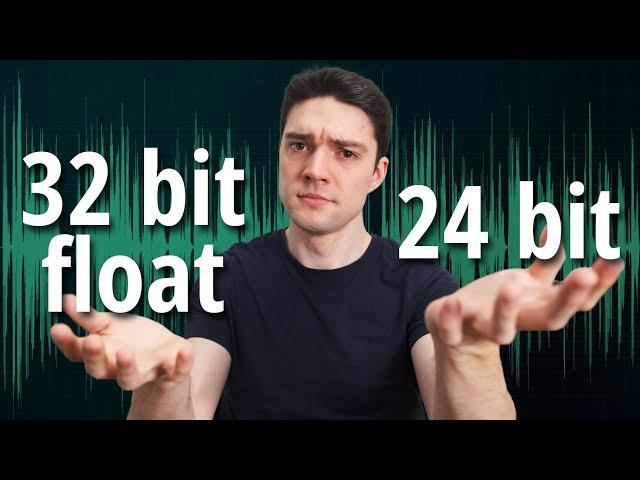
The TRUTH about 32 BIT FLOAT for audio recording– Really useful or marketing hype?
Комментарии:

There's nothing special about 32 bits when it comes to restoring clipping. 16 bits can also be restored by the use of synthetic restoration. The cost is: less resolution - in both cases. 32 bits don't automatically give a greater dynamic range. A choice to use some of the extra resolution for greater headroom must first be made. When a recording is clipped, the information is lost forever. Calling it restoring the original sound is a misnomer. It's all about a synthetic process where the data is guessed more or less accurately - usually less. To truly recover lost sound the process needs to understand the sound and what it consists of and basically replay the tones or voice from a library, in time, frequency, and phase domain - an impossible task. Today there's no sensible reason for not always using 32-bit float when the equipment supports it - especially when dealing with advanced filtering or synthetic voices and instruments.
Ответить
Bigger resolution means better quality and more crispiness. It is not about getting only extra DBs. Do we really need 4k, 8k TVs when HD is enough? With Sound Waves is the same. If you have ever calculated harmonics, you would know it make sense. The problem is with low quality plugins, limited DAWs, poor samples, limited synths and poor quality equipment.
Ответить
Thank you so much. it helps me to make decision!
Ответить
Testing has revealed that the second level analog to digital converters add noise in Zoom 32bit recorders and less noise, but some, in Sound Devices 32 bit recorders.
Ответить
For the end product you convert the audio file to 44.1 kHz 16bit 256 kbps AAC or OPUS (← 48 bit).
The very little quality loss is worth the tremendous amount of saved space.
But it's always convenient to keep lossless high quality audio as a source file for editing purposes.

32 bit recording is good for people that don't know what they are doing or they are learning and also for emergency situations and you don't have time to set everything properly. If you know what you are doing and NEVER make mistakes then your don't need 32 bit. More bits is ALWAYS BETTER in every scenario as an option.There are people than can record the BEST FUCKING AUDIO in 12 bits because they know what the fuck they are doing and have been doing it for a long time.
Ответить
24 bit converters gave us a solution we’d all been awaiting. When recording with 24bit converters, a -20dBFS peak level is totally usable, which was not the case in 16bit. 24bit recording gave us flexibility at the input, flexibility setting record levels. A 32bit recorder does not add to that input level flexibility as the limits of physics have been met already at the input. We can’t lower the source noise by 48 db and we can’t send 250Vac from our preamps to a DAW.
For those of us who have equipment with multi converter and preamp tech such as a few field recorders or the Neumann Digital microphone,the safety extension IS available for 32bit recording. For the other 99.999%, it is not. This distinction is important and often misunderstood. Any situation in which the recording engineer has control (even a second of soundcheck) will return perfect results recording to 24 bits, using 3 or 4 of those bits (18 to 26db) for safety, much like we have always set safe levels, but with far greater room for error. Recording with the same front end (mic, preamp) to a 32 bit file accomplishes absolutely nothing.
A 32bit float(ing point) digital file gives infinite range for the most unimaginably clumsy file handling such as very large gain and eq processing IN THE DIGITAL REALM without check the result AND simultaneously erasing the original signal. If these exceptional conditions match your workflow, then 32bit ‘Float’ is manna from heaven. Such situations might arise in field capture for film or TV. In the studio or live concert recording, these actions would disqualify any engineer. In 50 years, I’ve never encountered them.

I feel like the most useful place for 32bit float is in recorders and run and gun situations. One man crews for instance. Where you might not always have the ability to control levels in real time and have to set-and-forget. Or in situations where there's big differences in levels (think of meeting or whatever with speakers at all sorts of different levels) where you want to normalize the levels.
Ответить
bro, imagine a camera operator with a lot of stuffs to control, snario, direction photography, actors/models, and still have to think about the audio, I dont want to check if the file on the set if going well, I just want get the audio and make it works on the pos production, so, it's a game changer for run & gunprofessionals for sure
Ответить
Masterclass, thanks
Ответить
yes i need 32bits float. i dont want restriction.
Ответить
I'm still using 44.1khz 16bit. CD quality.
Ответить
32 bit den as 24 bit louder
Ответить
I am also SO GRATEFUL when I have an audio question and you have a video for it. I know I’m gonna get a real answer to my question and leave feeling a little smarter. Keep up the amazing work!
Ответить
But can you hear any difference
Ответить
I always wondered about it since the 32-bit float format has exactly the same precision as fixed point 24-bit PCM: 1 bit of sign and 23 bits of mantissa. Those extra 8 bits for the exponent can't do much lifting, even in a multi-stage recording setup. They're just handy to have as an intermediate during processing.
Ответить
What do you think of the 32 bit float from the PreSonus Quantum HD2??
Ответить
Thank you for explaining this. I am still curious about whether 32 bit float creates more safety around sudden spikes in db, like a sudden loud laugh. That type of sound makes me wonder whether 32 bit would be helpful.
Ответить
Excellent presentation; very helpful to me,and wonderful English!
It's probably the best I have heard for some time from a native speaker of Deutsch!
Lass es Dir gut gehen!

I think 32 bit is the great Equalizer. It makes Audio less intimidating for new entrants in the Audio space and gives them the opportunity to save time going through the learning curve to be able to get the same results with 24bit as some audio guy who had to learn 3 years to get it right.
With 32 bit, they can focus on others aspects of their productions more efficiently as well

which is better for recording loud motorcycle exhaust?
Ответить
Man TLM 103 with SSL 12 Work 32 bits ?
Ответить
It sounds like a good idea when recording audio along with video because it's hard to take care of audio levels when you are trying to record video as well so it's easy for distortion to happen that can't be fixed later. With 32 bit float you can fix the problem later and reduce the signal to below the distortion.
Ответить
Incredibly clear video that answered all my questions and some questions that I didn't even have!
Ответить
Thank you for this video 🙏🏽 for a non-audio expert like me, this actually confirms the need for 32bit f considering that in a run-&-gun situation i don’t have to be so meticulous about the audio recording and still have flexibility in post to make audio sound great even though i might have not set gain levels properly or placed the mic too far from my talent. In a perfect world I’d have an audio guy on-set making sure that audio is being captured properly, but in real life and with impatient clients 32bit F comes in handy 😎🙌🏽
Ответить
live band sometimes Destorted in that 16,24..i think..
Ответить
32bit best hz to record at , how to see antialiasing of an audio
Ответить
❤❤❤
Ответить
excellent ... thank you
Ответить
Awesome video, learned lots! So if one records in 32 bit float of talent that has a really deep and bassy voice, would 32 bit float be able to eq that said voice much easier than 24 bit? Or would 24 bit stand the same chance as 32 bit float. Had an interview recently where talent was a very deep and bassy voice, lav on tshirt and recorded in 24 bit. I'm seeing that I can clean it up ok but not great in post. I'm wondering if I had a 32 bit float recorded if I would have faired better? Or is it just a different mic technique?
Ответить
Best explanation I found. Thanks
Ответить
thanks.. great video.. so:
do I need a 32 bit interface: no
do I need 32 bit wav storage in my DAW :well no, but if you can you should enable it because it can save you in some circumstances, and you dont need to worry about recording too hot in your DAW. Got it.

jullian you are fantastic!!!what about dsd 1 bit recordings?why Paul McGowan, PS Audio is so fanatic on that?can we reocord on dsd?make a video on that
Ответить
"If you record shty audio it will sound shty in 32 bit float as well" hah. Well put. Great video!
Ответить
we even have 64bit float in cubase lol
Ответить
Please correct me if I'm wrong. I see a difference between bits required to represent the full dynamic range of audio and bits required to capture the dynamic range of audio with our devices. While 24 bits can represent all the dynamic range our ears can tolerate, in order to record it we have to capture audio above the noise floor of our signal chain. This is why instead of recording low level input with lots of headroom, we try to record at levels closer to the top and risk clipping. Ideally we could record with an average signal of -12 dBFS and never go over 0, but in practice this can be risky. We can record at a lower input level, but then raising the signal in post production we will also be raising the noise floor of our signal chain. A benefit to recording in 32 bits is setting your recording level so your average signal is higher above the noise floor. The extra headroom of 32 bit float may save the day when there would otherwise be clipping.
Ответить
Hi Julian, Thanks for your very instructive videos. The CD industry still uses 16bit/44.1kHz. I produced several CDs in classical music, and the tradition was to record also with 16bit/44.1kHz, by fear of truncation. What do you think/advise about ? Should one continue to record 16b/44.1kHz as CD requires, or increase the rates ? Greetings
Ответить
First, you're the best!! I understand that one can get the advantages of 32bit Float, if at all, regardless of type of analogue signal including Mic, Instrument, or Line level as long as the signal has not been through A/D conversion in the signal path when it reaches the 32bit Float interface . Is this correct?
Ответить
Hi, many thanks for this Video! I am new to Audio recording. I have only an old Rode Videomic pro and am intrested to buy a 32bit float audio recorder from Tascam (DR 10L -PRO) I always read they are used with Lav-Mic's.. But in theory i could attach the shotgun mic with it's preamp set to 20dB, to the Tascam DR 10L-PRO to record and bring it down in post? Or would the preamp from Rode Mic fry the preamp from Tascam? While the 32Bit Container/Format could handle it, the electronics may be the bottleneck here?
Ответить
And then, as a result (the rendered audio) even 24bit is hardly something needed, as most people won't even be able to notice a difference. (same with the hype of 96khz hi-fi non-sense some streaming platforms advertise)
Ответить
So, 32bit fixed point audio interfaces vs 32bit floating point interfaces? Is that a thing? The hardware has to be 32bit floating point for the recorded file in the DAW to have this dynamic range...is that correct @JulianKrause ?
Ответить
I’m hoping someone who records high gain guitar amplifiers, especially if they use genuine (I checked) Shure SM57’s
My cabinets are Marshall Mx412’s, Shure SM57, camera is a Zoom Q8n-4K Handy Video Recorder. Seemed like the ticket since Zoom products are known for good audio. 24bit while their handhelds are 32 bit float.
I recorded with the preamp set to between -6db and -12db. I bought a decibel meter to measure actual output at the cab, which was between 85db and 95db max at the grill cloth. Mic centered at the cone. As far back as 2’ just to see if placement helped. Recorded over and over.
Result: GARBAGE sound quality, mostly clipped and distorted. Finally gave up on this video camera/audio recorder which is supposed to be able to handle live music and guitar. Even turning down the volume to 70db it kinda sucked. Should t 24 bit handle up to 144db?
Any help would be appreciated. I just need to record my guitar videos and get Pat this logjam of garbage audio recordings. Sending this camera back of it’s the culprit. The SM57’s SPL is supposedly around 150? I’ve read they can go as high as 180.

32 bit float is a genuinely helpful safety net so to speak. I only wish they started making more 32bit float interfaces besides the 2input zoom one.
Ответить
32 Bit Float is a bigger container than usual. You can put a giant file inside it an it would not clip. What matters is what you put in this container. If you record distorted or bad sound then it would not magically make it better.
Ответить
Your videos are great, and I'm getting young Christopher Walken vibes. I love it!
Ответить
The Truth is that 32-bit float will become standard whether you like it or not.
Ответить
I use my Zoom F3 to record bat ultrasonics. For the huge and unpredicactable dynamic range encountered when recording those signals 32 bit float is a game changer.
So much simpler not to have to worry at all about gain settings when recording outdoors - usually in the dark!


























